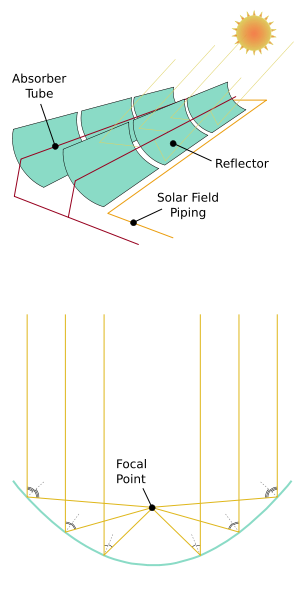Solar Parabolic Trough
(This is a series of articles on the various technologies that can be employed to trap the sun’s energy. This is the 4th part of the series.)
 A parabolic trough employs parabolic mirrors that act as collectors (can be coated silver or polished for more efficiency). A Dewar tube runs along its focal length. In case of a parabola, incoming rays which are parallel (sun’s rays arriving are nearly parallel) will be reflected always to the focus regardless of where they arrive on the dish. It tracks the sun’s movement from east to west. The number of parabolic troughs can be varied according to the system’s requirements.
A parabolic trough employs parabolic mirrors that act as collectors (can be coated silver or polished for more efficiency). A Dewar tube runs along its focal length. In case of a parabola, incoming rays which are parallel (sun’s rays arriving are nearly parallel) will be reflected always to the focus regardless of where they arrive on the dish. It tracks the sun’s movement from east to west. The number of parabolic troughs can be varied according to the system’s requirements.
The mirrors used in parabolic troughs are in the shape of a parabola and are usually of a single piece of unit. However, 2 mirrors can also be used which are inclined at an angle to make the shape of a parabola.
Since 2009, metal sheets have replaced glass in the parabolic troughs. Silver polymer is employed for constructing it. Advantage is in the form of much less weight and less cost. The efficiency is not compromised upon.
The sun’s rays concentrate on the focus of the parabola which has a Dewar tube running along its length. It can contain water, oil, or as in modern technology available nowadays- molten salt. The heat generated is used to produce steam which generates a turbine producing electricity. The fluid is passed again after heat exchange and the process is repeated.Efficiency is around 15%. Thermal storage insulated tanks can be used for storage of molten salt for use at night time. The next challenge is to increase night time operations to twelve hours from the current six hours to provide all round electricity.
Since the sun moves through the tropics, the entire solar assembly should also track the sun otherwise efficiency will be severely compromised. This was done manually earlier but nowadays, motors and computer simulation models are used that automatically calibrate for the position change of the sun.
Advantages:
- The low cost provided by parabolic troughs is the greatest advantage. The cheapest source at present is solar parabolic troughs. Considerable working experience has been gained from their working over the years.
- Parabolic troughs generate very high temperatures which are suitable for steam generation. Thermal storage in insulated tanks can provide electricity at night.
- Solar PV’s are expensive and more area can be covered by parabolic troughs which employ cheaper mirrors.
Disadvantages:
- Sun tracking is necessary to maintain solar collection by parabolic troughs otherwise the output will reduce. This increases cost and maintenance associated in maintaining the moving structures.
- High concentrated sunlight is essential for good working of a parabolic trough. In diffused light, there is an inability to focus sunlight efficiently and the output decreases dramatically. Solar cells can provide some output even in diffused light, not so the case in solar parabolic troughs.
- Parabolic trough plants require large amount of land while solar PV’s can be conveniently places on rooftops.
- Molten salts freeze at high temperatures in the range of 120ºC to 220ºC. There is a risk of it freezing at night which affects plants operations.
Read Part 1 and Part 2
Image credit: Andrew Buck, Wikipedia

